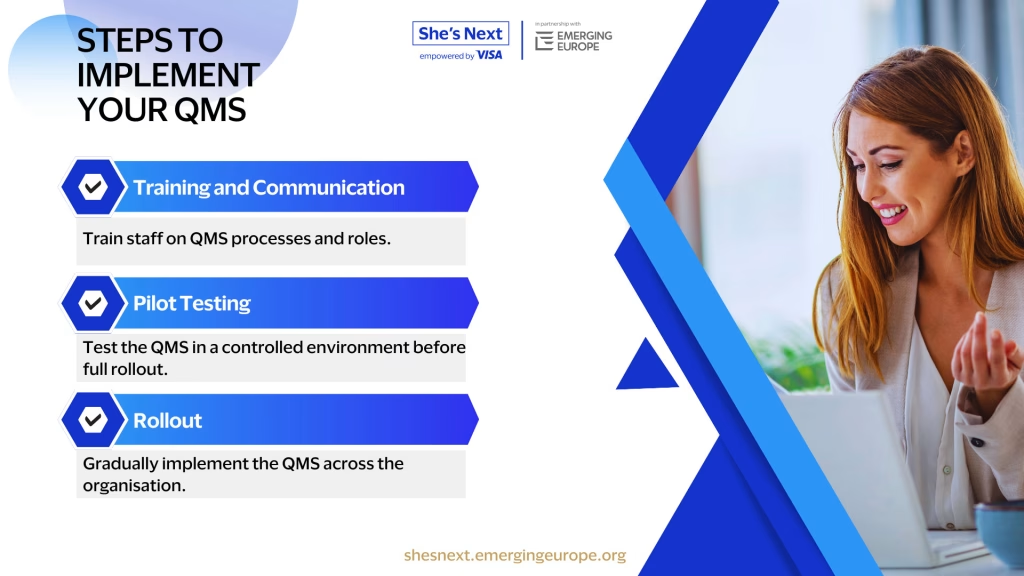
Implementing, Monitoring, and Maintaining a Quality Management System: Ensuring Long-term Success
A well-designed Quality Management System (QMS) is essential for organisations that seek to ensure consistency, meet customer expectations, and drive continuous improvement. However, designing a QMS is just the beginning; its successful implementation and maintenance are crucial for long-term success.
This guide will explore the steps necessary to effectively implement, monitor, and maintain your QMS.
Implementing Your QMS
Training and Communication
One of the most important aspects of QMS implementation is ensuring that all staff members are properly trained. Employees need to understand not only the processes outlined in the QMS but also their roles in upholding quality standards. Clear communication across all levels of the organisation is vital to ensure buy-in.
For instance, conducting training sessions or workshops tailored to different departments can make employees feel involved and knowledgeable about their specific contributions to the system.
Additionally, having accessible resources like manuals and visual guides can further reinforce learning.
Pilot Testing
Before rolling out the QMS across the entire organisation, conducting a pilot test in a smaller, controlled environment helps identify potential issues and smooth out any inefficiencies. For example, a retail company might pilot test their QMS in a single store or region to evaluate how well processes are implemented and what adjustments are needed.
The feedback gathered from this phase will allow for modifications and refinements, ensuring a more seamless implementation on a larger scale.
Rollout
Once the pilot test has been refined, it’s time for full-scale implementation. A phased rollout may be appropriate for larger organisations, starting with key departments before expanding to the entire company.
For instance, a manufacturing company could begin QMS implementation within its production department, ensuring processes are stable before moving to other departments like procurement and logistics.
Throughout the rollout, maintain open channels of communication with staff, provide ongoing support, and address any concerns promptly to ensure a smooth transition.

Monitoring and Maintaining the QMS
Regular Audits
Conducting regular internal and external audits is critical to monitoring the effectiveness of the QMS. Schedule audits periodically to evaluate whether processes are being followed and whether they are still aligned with the QMS objectives.
Audits should assess everything from document control to process efficiency. Tools like QT9 QMS can automate the audit scheduling and reporting processes, making it easier to maintain a consistent audit cycle.
Regular audits provide the opportunity to uncover inefficiencies and ensure compliance with standards such as ISO 9001.
Performance Reviews
In addition to audits, regular performance reviews of the QMS should be conducted to assess how well the system is performing in meeting its objectives. For example, if the goal is to reduce product defects by 10%, the review should compare current defect rates against this target.
Use key metrics like customer complaints, defect rates, and process efficiency to evaluate performance. Based on these reviews, adjustments can be made to refine processes and ensure the QMS continues to deliver on its goals.
Continuous Improvement
Continuous improvement is at the heart of a successful QMS. The results of audits, performance reviews, and staff feedback should inform an ongoing process of refinement.
For instance, feedback from employees on the shop floor may suggest a more efficient way to manage quality checks during production, while customer feedback might highlight areas for improvement in customer service processes.
A QMS that evolves and improves over time will better meet both business objectives and customer expectations.
Implementing, monitoring, and maintaining a QMS is an ongoing process that requires commitment and attention to detail.
By training staff, piloting the system, conducting audits, and continuously improving processes, organisations can ensure that their QMS remains effective in the long term.
A strong, well-maintained QMS not only enhances product or service quality but also promotes a culture of continuous improvement across the entire organisation.
New Free Courses — Made for Ambitious Women Entrepreneurs!
It’s time to grow smarter, adapt faster, and take your business global.
Explore two powerful courses available exclusively to She’s Next members:
The Reinvention Masterclass for Start-up Founders
Beyond Borders: Building for Global Success
Enroll today — it’s free!






Responses